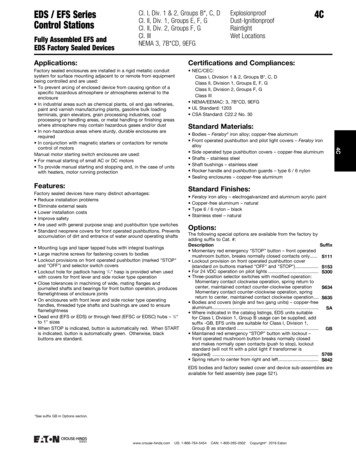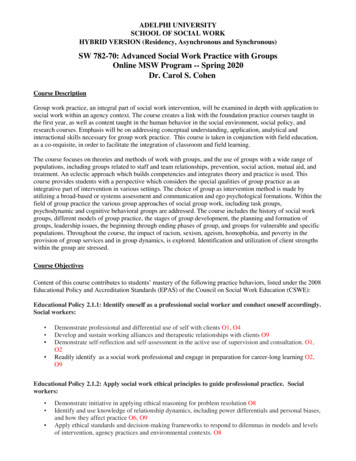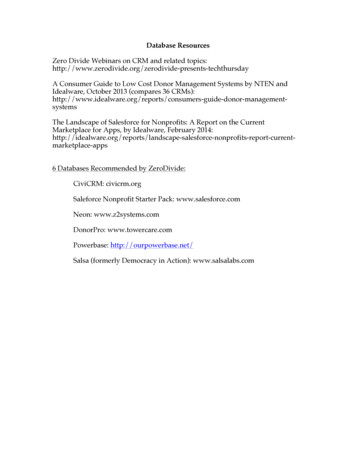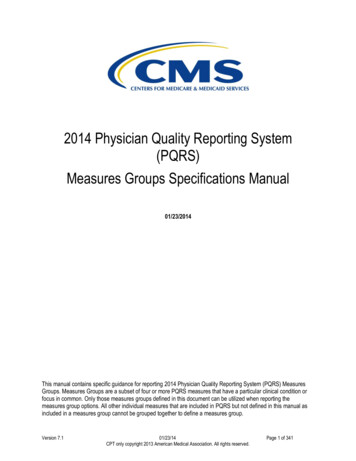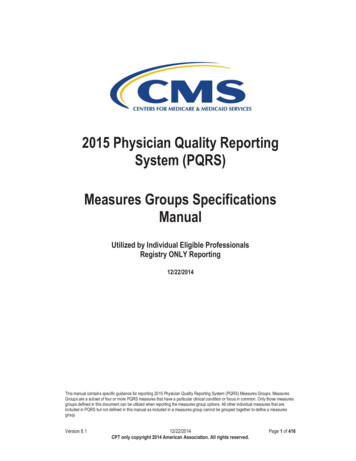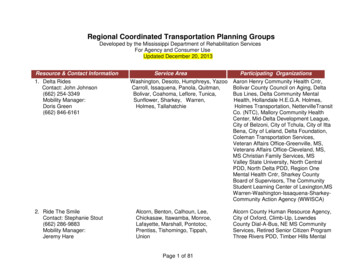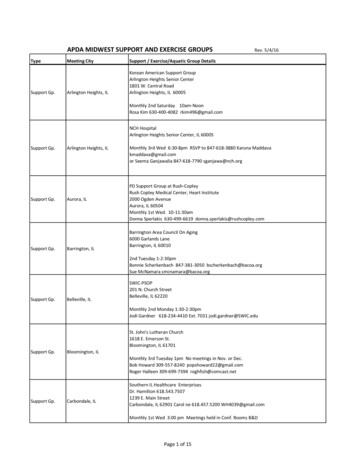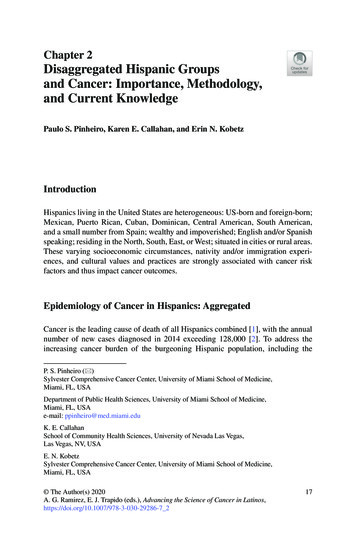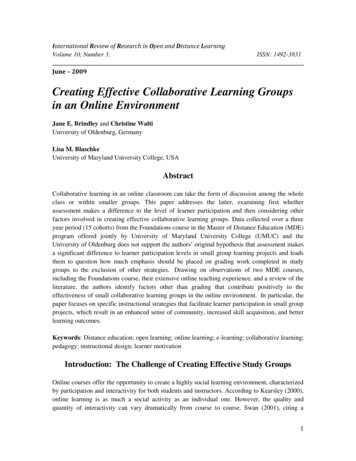
Transcription
International Review of Research in Open and Distance LearningVolume 10, Number 3.ISSN: 1492-3831June – 2009Creating Effective Collaborative Learning Groupsin an Online EnvironmentJane E. Brindley and Christine WaltiUniversity of Oldenburg, GermanyLisa M. BlaschkeUniversity of Maryland University College, USAAbstractCollaborative learning in an online classroom can take the form of discussion among the wholeclass or within smaller groups. This paper addresses the latter, examining first whetherassessment makes a difference to the level of learner participation and then considering otherfactors involved in creating effective collaborative learning groups. Data collected over a threeyear period (15 cohorts) from the Foundations course in the Master of Distance Education (MDE)program offered jointly by University of Maryland University College (UMUC) and theUniversity of Oldenburg does not support the authors‟ original hypothesis that assessment makesa significant difference to learner participation levels in small group learning projects and leadsthem to question how much emphasis should be placed on grading work completed in studygroups to the exclusion of other strategies. Drawing on observations of two MDE courses,including the Foundations course, their extensive online teaching experience, and a review of theliterature, the authors identify factors other than grading that contribute positively to theeffectiveness of small collaborative learning groups in the online environment. In particular, thepaper focuses on specific instructional strategies that facilitate learner participation in small groupprojects, which result in an enhanced sense of community, increased skill acquisition, and betterlearning outcomes.Keywords: Distance education; open learning; online learning; e-learning; collaborative learning;pedagogy; instructional design; learner motivationIntroduction: The Challenge of Creating Effective Study GroupsOnline courses offer the opportunity to create a highly social learning environment, characterizedby participation and interactivity for both students and instructors. According to Kearsley (2000),online learning is as much a social activity as an individual one. However, the quality andquantity of interactivity can vary dramatically from course to course. Swan (2001), citing a1
Creating Effective Collaborative Learning Groups in an Online EnvironmentBrindley, Walti, and Blaschkenumber of authors, identifies course design as a critical factor in determining the quantity,quality, and type of interactivity (learner interaction with content, instructors, or peers) in acourse. Kearsley (nd) points to the importance of instructor skill in creating and managinginteraction in online courses, particularly when collaborative learning is required. However, healso points out that most people have little formal training in how to successfully interact or workwith others and that the social milieu of online activities is quite different from in-personinteractions, thus requiring new skills and behaviors.Engagement, defined as “student-faculty interaction, peer-to-peer collaboration and activelearning.” (Chen, Gonyea, & Kuh, 2008, para. 2), has been positively related to the quality ofthe learning experience. Social learning or learning as part of a group is an important way to helpstudents gain experience in collaboration and develop important skills in critical thinking, selfreflection, and co-construction of knowledge. Online learners should not be impoverished interms of social learning because they cannot or choose not to come to a campus. Access toeducation should not mean merely access to content (which is readily available without formalenrollment with an educational provider); rather, it should mean access to a rich learningenvironment that provides opportunity for interaction and connectedness. Quality learningenvironments include opportunities for students to engage in interactive and collaborativeactivities with their peers; such environments have been shown to contribute to better learningoutcomes, including development of higher order thinking skills. Specific pedagogical benefits ofcollaborative learning include the following:Development of critical thinking skills,Co-creation of knowledge and meaning,Reflection,Transformative learning. (Palloff & Pratt, 2005)Different learning styles and cultures can be accommodated more easily because effectivecollaborative learning values diversity (Palloff & Pratt, 2005). Further, skills gained from theexperience of collaborative learning are highly transferable to team-based work environments(Shaw, 2006). Chapman, Ramondt, and Smiley (2005) also establish a strong link betweenbuilding effective online communities and deeper learning and confirm that “. the world of workrequires that learners can apply, analyse, synthesise and evaluate information.” (p. 220). Despitethese documented benefits and the intense popularity of informal social networking using Web2.0 tools and mobile devices, collaborative learning in the form of small groups (four to sixpeers), which is not of their own choosing, is often dreaded and avoided by online learners.Online learners who seek flexibility in their study situations can view participation in grouplearning as an impediment to their progress and often balk at or at best tolerate collaborativelearning situations imposed by course design. Students may have reservations about their abilityto work as part of a group (Harasim, Hiltz, Teles, & Turoff, 1998), or they may have becomereluctant to participate based on negative past experiences of working with an unproductive orvery difficult peer, having had to carry more than their fair share of the workload, or havingreceived a grade that they felt did not reflect their level of contribution to a group project.2
Creating Effective Collaborative Learning Groups in an Online EnvironmentBrindley, Walti, and BlaschkeOne proposed method of ensuring learner participation in online collaboration is to demonstratethe value of group learning by assessing (defined here as assignment of a grade) both the productand process of group work (Swan, Shen, & Hiltz, 2006). Swan et al. (2006) propose that“Assessment can be seen as the engine that drives student course activity, online or off. It isparticularly important in encouraging and shaping collaborative activity online” (p. 45). Thispaper proposes an alternate perspective. The authors present data gathered over a three yearperiod from a class in an international master of distance education (MDE) program that indicatesthat the introduction of grading has made no discernible difference to participation in studygroups based on a straightforward comparison of participation rates between the graded and nongraded sections. Based on experience from this course and a model from another course in thesame program where group work has never been graded, the authors propose alternative methodsto encourage learners to experience the value of collaborative learning by creating study groupexperiences that are motivating and rewarding.Collaborative Learning and ConnectivismSiemens (2005) proposes a contemporary theory of learning called connectivism that recognizesthe impact of technology on society and ways of knowing. Although some writers havechallenged both the need for a new learning theory and whether connectivism meets theparameters of theory (Kop & Hill, 2008), Siemens provides a premise and a framework that arevery useful for understanding collaborative learning in an online environment. From hisviewpoint, learning in the digital age is no longer dependent on individual knowledge acquisition,storage, and retrieval; rather, it relies on the connected learning that occurs through interactionwith various sources of knowledge (including the Internet and learning management systems) andparticipation in communities of common interest, social networks, and group tasks.From this perspective, learning consists of retrieving information from self, others, and machines,collaborating to create knowledge, and applying information to current contexts. Hence, Siemens‟(2005) learning theory is about individuals connecting with each other and with technology.Effective learners are those who can cope with complexity, contradictions, and large quantities ofinformation, who seek out various sources of knowledge, and who can create and sustain learningcommunities and networks. According to Siemens (2005), learning ecologies (communities andnetworks) facilitate important information sharing and co-construction of knowledge whileencouraging life-long learning in the individual as well as the group.In a collaborative learning environment, knowledge is shared or transmitted among learners asthey work towards common learning goals, for example, a shared understanding of the subject athand or a solution to a problem. Learners are not passive receptacles but are active in theirprocess of knowledge acquisition as they participate in discussions, search for information, andexchange opinions with their peers. Knowledge is co-created and shared among peers, not ownedby one particular learner after obtaining it from the course materials or instructor. The learningprocess creates a bond between and among learners as their knowledge construction depends oneach other‟s contribution to the discussion. Hence, collaborative learning processes assist studentsto develop higher order thinking skills and achieve richer knowledge generation through shared3
Creating Effective Collaborative Learning Groups in an Online EnvironmentBrindley, Walti, and Blaschkegoals, shared exploration, and a shared process of meaning making (Brookfield, 1995;Christiensen & Dirkinick-Holmfeld, 1996; Jonassen, Davidson, Collins, Campbell, & Haag,1995; Palloff & Pratt, 2005).Connectivism (Siemens, 2005) recognizes that in the online learning environment, seeking andconstructing knowledge is most often accomplished through interaction and dialogue. The authorsof this paper agree with Siemens and like most online educators acknowledge the importance ofcreating learning environments that promote group connectivity and collaboration experiencesthat help students to acquire the skills necessary to create and effectively participate in learningcommunities and social networks. The question that arises for online teachers is how toincorporate small group learning experiences into courses that are inviting and provideproductive, engaging, and skill building spaces for learners, which encourage them to repeat thecollaborative learning experience independently.Siemens (2002) notes that learner-learner interactions in an e-learning course can be viewed as afour stage continuum:1. CommunicationPeople „talking,‟ discussing2. CollaborationPeople sharing ideas and working together (occasionally sharing resources) in a looseenvironment3. CooperationPeople doing things together, but each with his or her own purpose4. CommunityPeople striving for a common purposeThis continuum of involvement provides a useful framework for thinking about scaffolding withlearners through progressively more complex interaction skills leading to the creation of aneffective working group. Siemens (2002) proposes that in an online course, interaction willprobably not go beyond communication/collaboration most of the time. He notes that while it isnot realistic to expect community in many online courses, it should be possible in graduate levelprograms with high learner-learner contact. In the MDE program that provides the context for thispaper, acquisition of skills associated with collaborative learning is an explicit goal. Courses havelittle static content, other than a comprehensive syllabus and course outline, and are heavilydriven by interaction among learners and between instructor and learners. Small group projectsare a common learning method, and discussion has intensified about the merits of gradingstudents‟ collaborative group work as a means of motivating student participation. The studydescribed in this paper is a form of reflective practice in that it considers the literature and datafrom the program for the purpose of informing these discussions.4
Creating Effective Collaborative Learning Groups in an Online EnvironmentBrindley, Walti, and BlaschkeObjectives and Research HypothesisThe initial objective of the study was to determine whether grading collaborative projects ispositively related to higher student participation levels in small group work. The hypothesisleading to the research was that student participation levels would be higher in small group workwhere group projects were graded as compared to those where they were not graded. The resultsfrom the investigation of this main hypothesis led to a post-hoc research question about factorsother than grading that might positively influence participation in collaborative learning in smallgroups. These factors are discussed in the latter half of the paper.Context and MethodologyIn January 2000, the University of Maryland University College (UMUC), USA, and OldenburgUniversity, Germany, began offering a joint online master‟s program, the Management ofDistance Education (MDE). Courses within the program are provided online and delivered usingUMUC‟s proprietary course software, WebTycho. WebTycho supports asynchronous dialogueusing main conference threads as well as collaboration for smaller groups within a study grouparea using synchronous online chat and collaborative documents (See Figure 1).Students in the MDE program are adults who have attained at least a baccalaureate degree and aregenerally between the ages of 30 and 50 (67%); they are mainly from the United States, with aminority from other countries. Approximately 70% are female and 30% are male. Most areworking full- or part-time (90%). The classes from which the data was collected for the purposeof this study fit this profile (Porto, Bernath, & Walti, 2006).The Foundations of Distance Education (MDE 601) course is intended to provide graduatestudents with a foundation of the knowledge, skills, and attitudes required for them to becomecompetent practitioners of distance education. This initial, introductory course to the MDEprogram has been offered continuously since 2000 during each university semester – spring,summer, and fall; at times, more than one section has been offered per semester. The course isstructured into four modules with a main conference posting area for each module. Smaller studygroup areas with three to six students can be found in the study group conferences, which are onlyaccessible by the instructor and the student members of the respective study group.5
Creating Effective Collaborative Learning Groups in an Online EnvironmentBrindley, Walti, and BlaschkeFigure 1: WebTycho conferences and study group areas.The MDE 601 course includes two study group projects:1. In the first module, students collaborate within their individual study groups to articulateand present a group definition of distance education.2. In the fourth module, students select and/or define a typology of distance educationinstitutions (e.g., dual-mode and single-mode institutions) and then conduct research oninstitutions that meet the schematic defined for the typology. They then present theresults of their collaborative efforts in a group paper.Data was gathered from fifteen sections of MDE 601, from 2005 to 2008. The collaborative workin module1 has never been graded and the collaborative work in module 4 of the first 13 sectionsof the course offered during the period covered by this study (spring 2005 to summer 2007) wasnot graded. However, during this time detailed instructor feedback for group projects wasprovided. In the sections of fall 2007 and spring 2008, faculty began to assign a formal gradeafter repeated requests by students to have this second group project graded. The group projectswere then assigned a cumulative grade based on the following: 1) the collaborative group process,2) the final product (group paper), and 3) peer-to-peer evaluation of the collaborative work.During the period for which data was collected, the number of students within a course sectionranged from 13 to 35, with an average of 20 students per section, and the study groups comprisedon average four to five students each. The content and instructions for the collaborative groupproject assignments in modules 1 and 4 were consistent over this period.For the purposes of the study, the following data was collected for each of the 15 course sections:1. number of students,2. number of posts in each study group area during each of module 1 and module 4.6
Creating Effective Collaborative Learning Groups in an Online EnvironmentBrindley, Walti, and BlaschkeCalculations were made for each course section as follows:1.2.3.4.5.total number of posts in both study group areas (module 1 and module 4),percentage of posts in module 1 compared to total posts for both study group areas,percentage of posts in module 4 compared to total posts for both study group areas,average number of posts per student during each of module 1 and module 4,comparison (by multiple) of number of posts in module 4 compared to module 1.All of these figures are presented in Table 1.FindingsWhen comparing study group behaviour between module 1 and module 4 within each coursesection, it was found that participation levels during the second study group project were onaverage 2.05 times the participation levels for the first study group project when neither modulewas graded (see Table 1). This finding for sections where neither group project was graded(spring 2005 to summer 2007) was expected because the study group project in module 4 issignificantly more complex and work-intensive than the project in module 1, requiring moreinteraction among group members. It was expected that there would be noticeably more studygroup activity ( 2.05 times that in module 1) during the second study group project onceinstructors initiated grading for that project. However, this was not the case. When the secondgroup project was graded (fall 2007 and spring 2008), participation levels during the second studygroup project were on average 1.93 times the participation levels during the first study groupproject.To further control for the varying levels of participation (activity as measured by # of postings)that naturally occur between course sections, participation levels between graded and non-gradedsections of the course were compared by considering the level of activity within module 4 in thecontext of total activity in both modules within each section of the course. The initial findings infall 2007 did not support the original hypothesis that participation levels would increase when themodule 4 project was graded; these findings were further reinforced in spring 2008. In both ofthese sections, which had a grade assigned to the second study group project, student participationlevels remained consistent with those in previous sections where there had been no grading. Inother words, in a straightforward comparison of participation levels as measured by percentage ofpostings in module 4 (# of postings in module 4 study group area/total # of postings in both studygroup areas), there was no discernible increase or decrease in participation levels when a gradewas assigned in comparison to student participation levels in the thirteen previous offerings of thecourse when a grade was not assigned to the group project (see Table 1 and Figure 2). Thesepreliminary findings do not show an immediate benefit in assigning grades to the collaborativestudy group project, but this is based on only two sections of the course that have had gradedprojects. A greater number of cohorts and a more extensive statistical analysis are requiredbefore any firm conclusions can be reached.7
Creating Effective Collaborati
also points out that most people have little formal training in how to successfully interact or work with others and that the social milieu of online activities is quite different from in-person interactions, thus requiring new skills and behaviors. . In January 2000, the University of Maryland University Col



